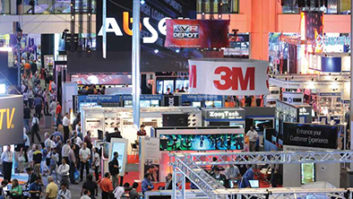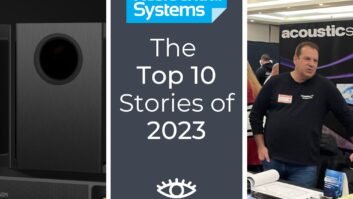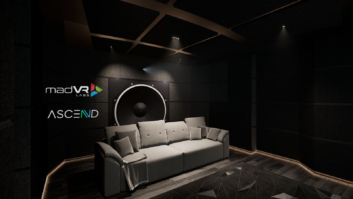As I sat on the plane to Orlando early Wednesday morning, (a flight I am familiar with since us Buffaloioans must escape to Florida during our bitter cold winters or risk freezing to death), I was excited for what lay ahead. I was off to my first InfoComm for a total of 50 hours and had packed my schedule accordingly. I couldn’t help but wonder if commercial and residential integration was really so different or, like IT and AV, have begun to merge.

So what did I find out? There is certainly crossover and more than that; there is opportunity. Below is a summary of the most relevant products and technology that I saw at the show and how it may relate to our resi world.
Digital Signage: My retinas are still burning from the beautiful bright displays. Digital signage is nothing new, and yet it is still a growing market. Being fully dedicated to the category, however, may require starting an entirely separate division of your company. If you end up getting into content or monthly charging, it can be an entirely different beast than integration. InfoComm showed a host of new, larger, interactive signage, and new uses for the displays—from retail outlet window dressing to video mapping projection on white objects (like clothing on mannequins). It was a whole new level.

LG even introduced new aspect ratios for specific digital signage applications like movie theaters and beyond. Outdoor TVs were as bright as posters. Displays were as large as wallpaper.

A Place for Ultra HD (4K): we all know that 4K may look pretty, but we’re not sure what its place in the home will be yet. Sharp had some great ideas on how to use the resolution. The company had areas set up demonstrating the advantage of 4K when using CAD drawings (super fine detail), video editing (one frame and a time) and also for the finance guys. Apparently there have been studies done that show when a financial trader has eyestrain, he or she may make bad decisions. Although the most fun use that Sharp was showing can best be explained by this video.
This may not make us custom guys money today or tomorrow, but it is an excellent example of how to take a great technology and find some novel uses for it.
Trickle Up/Down Theory: Many commercial technologies will trickle down to the residential market. One I’m excited for is laser projection that was presented by both Sony and Panasonic. No more lamp replacement or waiting for lamps to warm up or cool down. Sony was touting 20,000 hours of use. That’s 8 years at 10 hours a day. That would save about $1,800 in lamp replacement.
Then there is the trickle up theory: residential units or systems that were born in our market and grew into the commercial marketplace. This is exactly what URC Total Control was up to. They announced Total Control Flex, based on their successful Total Control system released last year; the Flex is a new open format programming system. Hardware stays the same.
Teleconferencing: A theme at the show was “playing well with others.” Many companies were showing the ability to walk into a conference room with an Apple device, Android, and/or a laptop and be able to “present” and collaborate (another big buzz word at the show) with the room. Crestron announced AirMedia, which would work similarly to an AppleTV but would also supply an IP address for any other units, allowing them to “throw” their screen to the display. (Click here for my write up on the unit).
This is an area to watch, not only for smaller “crossover” conference rooms that we resi folks are doing, but also for the crossover to the home. Imagine walking into anyone’s home with any smart device and being able to share music, photos, videos, and more. Sure we can make that happen now, but not seamlessly on multiple platforms. Just wait until our display devices grow up to become video conferencing tools as well—at least that’s my guess. Grandma usually can use a TV. Why can’t we call her on it?
InfoComm had its highest attendance ever, and that is good news for us. The more they spend “up there” the more tech will be created to trickle down and be utilized in our market.
Are commercial and residential so different? I think they still are two separate worlds, but a bridge has been built and the bounties are no longer as clear.
Craving more about the show? Visit our sister publication’s website for more info about the hottest new products and tech from InfoComm 2013.
Heather L. Sidorowicz is project manager/designer for Southtown Audio Video in Hamburg, NY.



